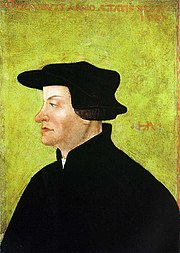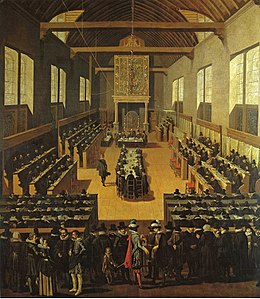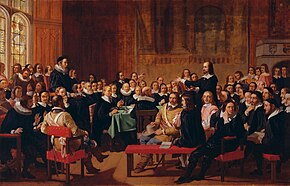History of Reformed Christianity
Reformed Christianity originated with the Reformation in Switzerland when Huldrych Zwingli began preaching what would become the first form of the Reformed doctrine in Zürich in 1519.
Zwingli and
Reformed faith spread throughout Europe in the 16th century, with different character in different places. Calvinism was the dominant form of Protestantism in France. After a period of struggle, Calvinists were officially tolerated there. Under the leadership of John Knox, the Church of Scotland, which is Reformed, became the established church in Scotland. In the Netherlands, Calvinism also became the official established religion following a period of persecution. During the Reformation, Calvinism was the primary Protestant faith in Belgium but was eradicated in favor of the Counter-Reformation. Germany remained predominantly Lutheran during the 16th century, but Reformed worship was promoted intermittently by rulers in Electoral Palatinate, Margraviate of Brandenburg, and other German states. Reformed ideas also influenced Protestants in Eastern Europe, especially Hungary and Romania. The reform of the Church of England was also influenced by Reformed theologians, and remained so throughout the 16th century.
Origins (1519–1531)

At first Zwingli regarded Luther as an ally, and union between the followers of Zwingli and Luther may have been possible but for controversies over the
Throughout the 1520s, Zwingli's influence grew in Switzerland,[8] though many Swiss, especially in rural and forest areas, remained loyal to the Catholic church and opposed Zwingli's reforms.[9] Before 1530, some southern German cities supported Zwingli, and some German Lutheran theologians in other areas of Germany developed sacramentarian views independently of Zwingli, but they were quickly silenced by Lutheran theologians in Wittenberg.[10] In early 1531, Phillip of Hesse formed the Schmalkaldic League, solidifying the Lutherans' hold on Germany to the exclusion of Zwinglianism.[11] Meanwhile, Zwingli began to use force aggressively to solidify Protestant gains in Switzerland. Following success against Catholics in the First War of Kappel of 1529, Zurich enforced a harsh blockade on Catholic cantons, leading to the Second War of Kappel in 1531. The Zurichers were defeated, and Zwingli was killed in the battle. Catholics continued to hold power in a majority of Swiss cantons, though three-fifths of the population was Protestant.[12]
Second generation (1531–1555)

While Reformed ideas and churches found ever-widening distribution during this period, reaching as far as England and Poland, Lutheranism also increased its dominance in the Holy Roman Empire.[19] The Augsburg Interim of 1548, a settlement between Holy Roman emperor Charles V and Protestants resulting from the Schmalkaldic War, made some concessions to Protestants but forced those who wished to practice their religion legally to adopt practices which the Reformed found repugnant.[20] Some isolated Reformed churches were able to hold on in Germany including a church in Emden led by Polish reformer Jan Łaski which became an important center for Protestant refugees from the Low Countries. [21] London and a few other cities in England; Wesel, Aachen, and Frankfurt, Germany; and Geneva, Switzerland were also important cities for Reformed refugees from the Low Countries, northern France, and other areas of the Holy Roman Empire where they were not tolerated. "Stranger churches" were established in these cities for refugee Protestants.[22]
The Reformed movement was complex and variegated during this period, but the French reformer of Geneva John Calvin was arguably the most influential Reformed theologian of his time and his impact was long-lasting. His
Spread (1555–1600)
The Reformed faith took different shapes in different parts of Europe. In France, groups of Christians influenced by Protestant writers (who became known as
The Netherlands was affected by Reformation ideas early on due to linguistic and commercial ties with Germany.
There was frequent interchange between Swiss and German Protestants early in the Reformation, and Bucer's Strasbourg had some Reformed characteristics, but Germany remained firmly Lutheran and anti-Calvinist through 1560.[40]
Following the death of Lutheran Wittenberg reformer
Polish priests began instituting reforms influenced by Calvin starting in the 1550s. In 1556 a diet at
Reformed ideas influenced the
Seventeenth century
The Netherlands

In 1603, the controversial
South Africa
In 1652, the
Germany
Calvinism gained support in Germany in 1604 when
In 1618, the
The Scandinavian countries of Denmark, Sweden and Norway had adopted Lutheranism early on, making it the official religion of their states. In 1667 however, the future King Christian V of Denmark married the staunchly Reformed Charlotte Amalie of Hesse-Kassel. As part of the marriage agreement, a Reformed minister was allowed to reside in Copenhagen as Charlotte's chaplain, but her Reformed faith prevented her from being crowned after becoming queen in 1670. In 1684, Christian V allowed for freedom of worship to non-Lutherans, and four years later, in 1688, the queen herself laid the cornerstone for the first Reformed church building. French Huguenots established the first and only Reformed body in Sweden in the late 18th century.
British Isles

In the British Isles, there were three established churches, the
The Westminster Assembly
In 1642, the
While they were intended to be binding on the entire nation, following the restoration of the monarchy in 1660, King
Independents and Baptists
In the second half of the 1630s,
The second Reformation (1621–1650)
The second Reformation was given different names even in different parts of the English-speaking world. These include:
- Switzerland: The Reformation in Switzerland is often considered to have lasted through this time
- Scotland: Second Scottish Reformation (see also: Covenanters)
- England:
- Puritans
- Pilgrims
- Netherlands: Nadere Reformatie ("Further Reformation")
Some of the articles on the first Reformation also cover the second.
Calvinism in the New World
In 1620, the
Presbyterianism would be established in the colonies in 1703, with the establishment of the Presbytery of Philadelphia. In time, two other presbyteries would be formed, constituting a Synod in 1717. In 1729, the Presbyterians would formally adopt the Westminster Confession and Catechisms as their confessional standards. Scottish Churches under the auspices of their churches in the old country would also establish churches in the 18th century, with the Associate Presbytery being established by the
The First Great Awakening (1730s and 1740s)
- UK and USA: Just as with the Protestant Reformation, so also the Awakening Generation.
- Netherlands: Nadere Reformatie is also considered to have continued until this time
Neo-Calvinism
- Around 1886
A version of Calvinism that has been adopted by both theological conservatives and liberals gained influence in the
New Calvinism
Around the beginning of the 21st century, "
See also
- Calvinism
- Presbyterianism
Notes
- ^ Stephens 2004, p. 99.
- ^ McNeill 1967, p. 29.
- ^ Benedict 2002, pp. 22-23; McNeill 1967, pp. 23–24.
- ^ Benedict 2002, pp. 24-25; McNeill 1967, p. 45.
- ^ Muller 2004, pp. 131–132.
- ^ Benedict 2002; McNeill 1967, pp. 45–47.
- ^ Benedict 2002, p. 35; McNeill 1967, pp. 50–51.
- ^ Benedict 2002, p. 36.
- ^ Benedict 2002, pp. 40-42.
- ^ Benedict 2002, p. 42-43.
- ^ Benedict 2002, p. 46.
- ^ Benedict 2002, pp. 47-48.
- ^ Benedict 2002, pp. 50–51; Muller 2004, p. 132.
- ^ Benedict 2002, pp. 58–59.
- ^ Benedict 2002, pp. 56–57.
- ^ Muller 2004, p. 134.
- ^ Benedict 2002, p. 61.
- ^ Benedict 2002, p. 63.
- ^ Benedict 2002, p. 65.
- ^ Benedict 2002, p. 65-67.
- ^ Benedict 2002, p. 68-73.
- ^ Benedict 2002, pp. 64–72.
- ^ Muller 2004, p. 132.
- ^ Benedict 2002, pp. 77–114.
- ^ Benedict 2002, pp. 132–133.
- ^ Benedict 2002, pp. 134–135.
- ^ Benedict 2002, p. 143.
- ^ Benedict 2002, pp. 146–147.
- ^ Benedict 2002, p. 148.
- ^ Benedict 2002, p. 157.
- ^ Benedict 2002, p. 156.
- ^ Benedict 2002, pp. 161–162.
- ^ Benedict 2002, pp. 163–164.
- ^ Benedict 2002, p. 174.
- ^ Benedict 2002, p. 185.
- ^ Benedict 2002, p. 182.
- ^ Benedict 2002, p. 188.
- ^ Benedict 2002, pp. 189–190.
- ^ Benedict 2002, pp. 200–201.
- ^ McNeill 1967, p. 268.
- ^ McNeill 1967, pp. 269–270.
- ^ McNeill 1967, p. 273.
- ^ McNeill 1967, p. 274.
- ^ McNeill 1967, pp. 275–276.
- ^ McNeill 1967, pp. 280–283.
- ^ McNeill 1967, pp. 283–285.
- ^ McNeill 1967, pp. 286–287.
- ^ McNeill 1967, pp. 309–310.
- ^ McNeill 1967, p. 311.
- ^ McNeill 1967, pp. 314–316.
- ^ McNeill 1967, pp. 320.
- ^ "The Reformed Church in Germany," retrieved 28 August 2013 http://www.rcus.org/index.php/history/243-reformed-germany Archived 28 August 2013 at the Wayback Machine
- ^ a b "A Primer on Baptist History: The True Baptist Trail" retrieved 31 August 2013 http://www.reformedreader.org/history/pbh.htm
References
- ISBN 978-0300105070.
- ISBN 978-0521776622.
- Stephens, W. Peter (2004). "The theology of Zwingli". In Bagchi, David V. N.; ISBN 0-521-77662-7.
- McNeill, John T. (1967). The History and Character of Calvinism. Oxford: ISBN 978-0195007435. Retrieved 25 January 2013.
Further reading
- Ballor, Jordan; Littlejohn, W. Bradford (2013). "European Calvinism: Church Discipline". European History Online. Leibniz Institute of European History (IEG). Archived from the original on 29 August 2013. Retrieved 29 August 2013.
- Hart, D. G. (2013). Calvinism: A History. New Haven, CT: Yale University Press.
- ISBN 978-0198753711.
